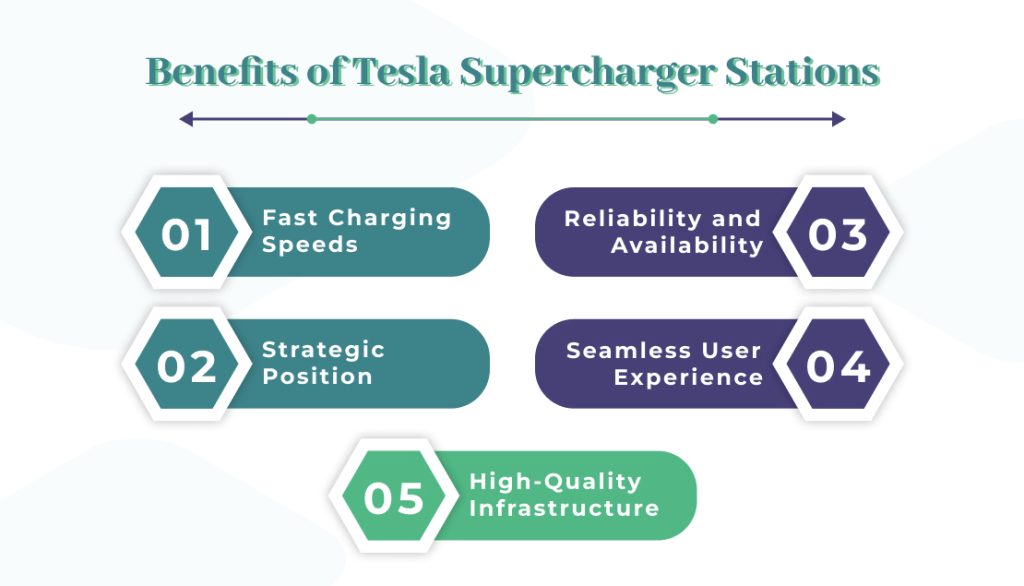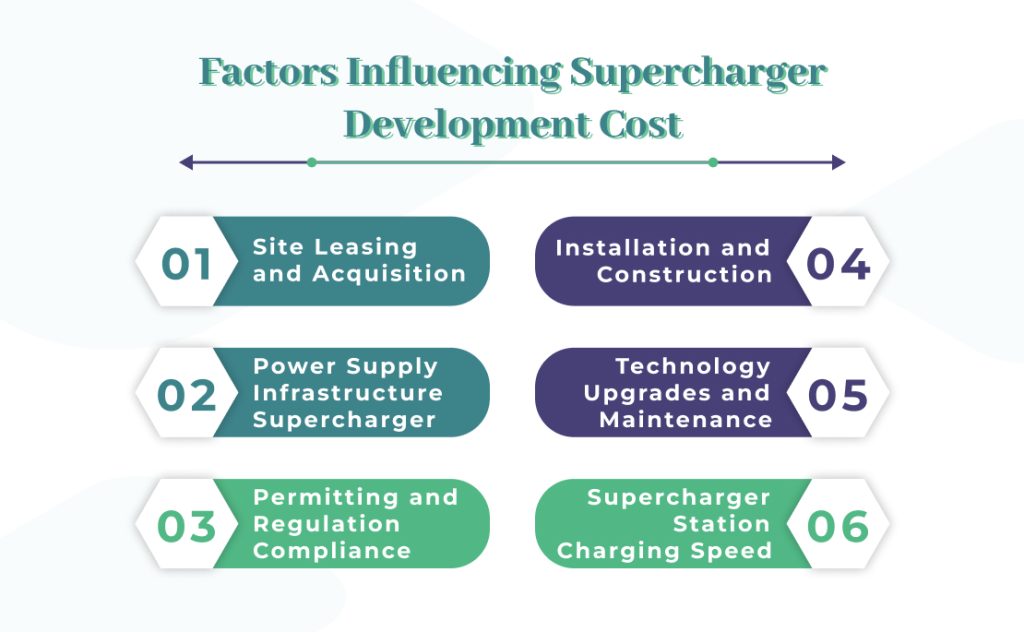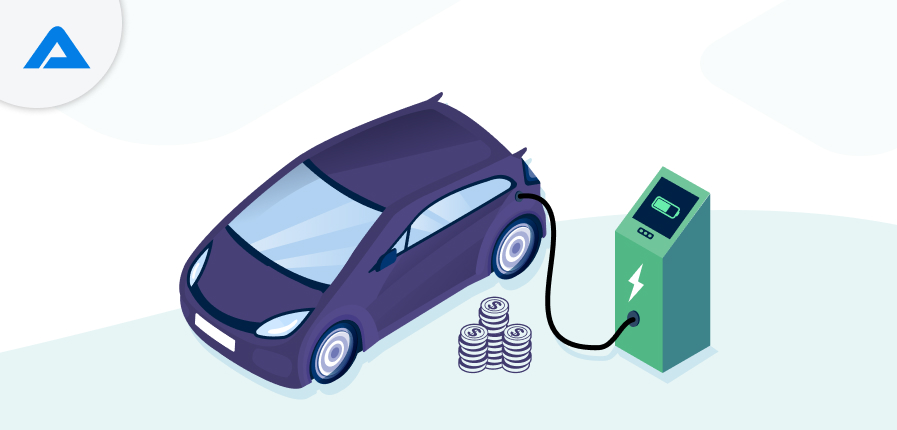In the last few times, Tesla has revolutionized the electric vehicle (EV) industry through its advanced technology and commitment to sustainable transport. One of the significant factors behind Tesla’s growth is its vast range, which includes Supercharger stations.
These charging stations permit Tesla owners to recharge their Tesla rapidly, making long-distance travel efficient and practical.
Tesla owners don’t need to be concerned about whether their Tesla will be unable to fill up with fuel “because it’s programmed to travel on routes with superchargers. Superchargers can be charged as much as 11 miles an hour, a significant benefit. Tesla’s vast network of fast charging stations has removed the main anxiety electric car owners face concerning being unable to charge their batteries.
There still needs to be more clarity even though there are more than 40,000 superchargers worldwide. Many people need help understanding what they do or what they cost. They have yet to learn about who could benefit from these devices.
We will take the curtain off the cost of hiring an EV charging app development company to develop an electric vehicle charging system similar to the Tesla Supercharger and understand what it’s all about.
What is a Tesla Supercharger?
A Tesla Supercharger is a car charger made explicitly for “rapid charging. ” In simple terms, it provides fast charging speeds, which can charge an electric vehicle battery in under an hour.
“Supercharger” is the general name of all the Superchargers in the world. Some are owned and operated by Tesla, while others are run by third parties. The network is vast, with over 500 sites (or hubs) around the globe—more than 1,000 of which are located in North America alone. Each location has multiple charging points, which means several cars can be charged into the network simultaneously.
Types of Tesla Superchargers
Three Supercharging stations are available worldwide: V1 Superchargers, V2, and V3.
V3 Superchargers are the most recent superchargers with the most modern technology, and they can provide charging speeds of 250kW. In contrast, the V2 Superchargers V1 and V2 have lower speeds of 150 kW instead.
V3 Superchargers could be upgraded, possibly providing speeds up to 324kW soon. V4 Superchargers could be used in the future but with no specific improvements. The first model will be constructed in Arizona and equipped with solar panels and a Megapack battery storage system.
Beyond the charging speed available, there’s nothing major to distinguish between the various types of superchargers. However, since V1 stations and V2 ones remain operating, you should be aware that you may not always receive the maximum speed of 250 kW. Luckily, Tesla’s Supercharger map makes it clear which speeds are available.

Ready to Revolutionize EV Charging? Hire a Skilled EV Charging Software Developer!

Pooja Upadhyay
Director Of People Operations & Client Relations
What is the Tesla Supercharger function?
Tesla’s Superchargers can be very easy to utilize. Place your car next to an appliance, plug into it, and wait for the cable’s lock to be locked correctly. The Supercharger will start providing power, and the logo next to the charging port will change to green.
No additional work is required since every car is connected to an account in Tesla’s Tesla application. Other charging networks for public use require drivers to confirm their charges using a smartphone app.
You’ll monitor the progress of your recharge on your car’s central display. It displays how quickly you’re charging, how many miles are added, how many miles are left in your battery, and how much this charge has cost you so far. The information is also available within the Tesla app if you need to leave your vehicle without supervision.
It’s also important to mention that the speed you charge will vary throughout the recharge session. The primary factor is whether other vehicles are connected at the same spot, as they’ll share the energy. Also, you won’t get 250 kW if more than four other vehicles are plugged in.
Another aspect common to all-electric vehicles is that charging speeds slow down as the battery’s capacity increases. This is especially noticeable once you reach the 80% mark when charging speeds slow to a point that may not qualify as rapid charging. You’re better off disconnecting the plug and driving away rather than waiting for 100 percent.
The most important thing to remember is that lithium batteries enjoy being charged less quickly, and regular charging can harm them. Therefore, try to restrict your Supercharger usage to long car trips or road trips and use slow AC charging for everyday driving.
Understanding the Importance of Supercharger Stations
Supercharger stations significantly contribute to the rapid growth and use of electric automobiles. They provide fast charging, allowing Tesla owners to reduce charging time dramatically on long trips. By strategically locating Superchargers along the most popular travel routes, Tesla has successfully eliminated “range anxiety” and made electric vehicles more attractive to customers.
Since Superchargers are all level 3 chargers, the exact charging speed can vary based on several aspects, including the Tesla model and the power output of the Supercharger, weather conditions, whether other electric vehicles are charging simultaneously, and the level of fullness or depletion the battery of your electric car is while you charge.
Benefits of Tesla Supercharger Cost Stations

The development costs for the Tesla EV charging system could be significant. However, the benefits they offer surpass the costs. Let’s examine the essential benefits associated with these stations.
Fast Charging Speeds
Tesla Superchargers deliver high-speed charging, which allows Tesla owners to charge their vehicles quickly. This makes travel over long distances more accessible and less costly and reduces the time to charge compared to conventional charging methods.
Strategic Position
Supercharger stations are strategically placed near major highways and transport routes, providing Tesla owners quick access to the charging infrastructure. This comprehensive coverage eases fear of range and helps encourage the use of electric vehicles.
Reliability and Availability
Tesla’s dedication to improving and maintaining the Supercharger network guarantees that chargers are safe and easily accessible. Tesla owners can count on these stations for charging needs, thereby enhancing the efficiency and convenience of their cars.
Seamless User Experience
Tesla Superchargers have been created to provide an unbeatable user experience. Their charging procedure is easy and intuitive, thanks to the simple connectors and clear directions. This user-friendly method helps improve Tesla owners’ overall happiness.
High-Quality Infrastructure
Tesla’s commitment to the highest quality of its infrastructure extends beyond Supercharger stations. The infrastructure has been designed to withstand weather conditions and heavy use to ensure long-term reliability and durability.
What’s the Cost of the Tesla Supercharger?
The fees you incur for supercharging will be charged automatically, as every vehicle is linked to a distinct Tesla account. So, you don’t need to consider carrying any credit or cash.
According to Tesla’s admission, the price of using the Supercharger will vary from location to location and could even change depending on the time of day you are charging. Prices are usually charged per minute or by the number of units (measured in kilowatt-hours, or kWh) you get off the grid.
Specific locations may also charge idle charges to vehicles left plugged in after completing the charging session. However, this can differ from one location to the next.
A supercharger charges per minute, not by the amount of power you consume. It is charged according to the tier system. There are four tiers total, each bigger than the one before it, and they change according to how fast your vehicle is charging.
The Tier 1 option is the most affordable and only applies to speeds below 60KW. Tier 2 covers 60kW up to 100kW. Tier 3 is for speeds between 100kW and 180kW, whereas the most expensive Tier 4 includes anything above 180kW.
In the past, Tesla offered free supercharging to a select group of customers, including customers who purchased their cars before the specified date or gained these credits via the referral program.
Factors Influencing Tesla Supercharger Development Cost

Various factors are considered when determining the cost of development of Tesla Supercharger stations. Several factors are considered when determining the development cost of Tesla. Let’s take a look at some of the most critical factors that affect the total price:
Site Leasing and Acquisition
Locating suitable locations to install Supercharger stations requires acquiring or renting land. The price varies based on the site, the land’s value, and the agreement with the property owners.
Power Supply Infrastructure Supercharger
stations must have a robust power supply system to offer rapid charging capabilities. This comprises electrical transformers, distribution equipment, and connections to the area’s power grid. The complexity and capacity of the infrastructure determine the cost of EV charging software development.
Permitting and Regulation Compliance
Tesla must obtain the necessary permits before constructing Supercharger stations and conform to local regulations. This involves paying charges and studies, environmental assessments, and other legal requirements contributing to the total cost.
Installation and Construction
Building the physical infrastructure of the Supercharger station requires a range of tasks, like setting up charging stalls, building canopies, and setting up the associated equipment. The complex nature of the design and the material used determine the construction cost.
Technology Upgrades and Maintenance
Tesla frequently enhances its Supercharger technology to improve charging speeds and efficiency. However, upgrades to existing stations and ongoing software maintenance costs can be higher.
Supercharger Station Charging Speed
In most cases, your price to Supercharge will depend on the amount of kW available, and you’ll pay more for a quicker charge. This is also referred to in the field of energy-based billing. In some regions, like Canada, you can pay for the time-based billing system through Supercharge. Most Tesla users prefer energy-based billing because it is better than time-based billing. You pay for a certain period, regardless of how much charge you add to your batteries.

How do I use a Tesla Supercharger?
Thankfully, using a supercharger isn’t much different than charging a car with petrol. However, there are a few essential distinctions between charging an EV like a Tesla or charging a different EV at a Supercharger.
To Tesla drivers
It’s simple for Tesla users: Connect your charger, click the button on the screen of your infotainment to open the charging port, and then connect the charger. The light will change to green after your Tesla is fully charged. You don’t need to pay the charger. Disconnect the connector, and the account associated with the car will be automatically charged.
The car’s charging status is displayed on the central infotainment screen when you plug in. However, this information is accessible via your smartphone’s Tesla companion app. This allows you to leave and return when informed that your vehicle is at the level you want to charge.
For drivers Other Than Tesla
It’s different if you want to utilize the Supercharger on a non-Tesla electric vehicle. You will require a Tesla account and the Tesla mobile application to access any of V3’s Superchargers available to all EVs.
Open the app and choose “Charge your non-Tesla’. Locate your Supercharger website, enter your payment details, select the stall you would like to charge from, and then plug it in. Once the charge has been processed, unplug that connector. Your account will be charged.
The exact process is available on newer Superchargers V4. However, they also have an electronic screen that allows users to pay with their credit or debit card onto the device. The Tesla app is optional for those who want to pay for the charger.
Future Expansion and Innovation
In the meantime, Tesla continues to increase its Supercharger network; they are also looking at innovative solutions to improve the charging capacity and meet the increasing demand for electric vehicles. Here are some innovations to be looking forward to:
V3 Superchargers
Tesla has announced V3 Superchargers, which have quicker charging speeds than previous versions. These chargers feature larger power capacities and advanced technology to speed up charging substantially.
Increased Charging Capacity:
Tesla hopes to expand the capacity of its charging stations at every Supercharger station, which will reduce waiting times during busy times and improve accessibility and ease of charge for Tesla owners.
Urban Superchargers:
Alongside expanding along major highways and transport lines, Tesla also focuses on installing Supercharger stations within urban zones. This project aims to address the ever-changing needs of city residents and improve the charging infrastructure overall.
Integration with Renewable Energy:
Tesla plans to combine supercharger stations with renewable energy sources like solar power. This aligns with their environmental commitment and minimizes the carbon footprint of charging electric vehicles.
How AddWeb Solution Can Help in the Development of EV Charging Software
EV charging software is vital for enabling EV charging operators and e-mobility service providers to manage all aspects of EV charging. It maximizes charger uptime and ensures drivers have an exceptional charging experience. As users increasingly opt for sustainable transportation, having a reliable charging system becomes environmentally and financially essential.
AddWeb Solution, a leading electric vehicle mobile app development company, offers state-of-the-art technology and advanced services in EV charging software. Our team excels in comprehensive requirement analysis, clearly understanding client needs and delivering tailored solutions.
We prioritize robust security measures and compliance with industry standards, ensuring the reliability and safety of our EV charging software. With AddWeb Solution, you can be confident in the quality and efficiency of your EV charging management system.
Conclusion
Tesla’s Supercharger infrastructure is a crucial aspect of the company’s growth in electric vehicles. The cost of developing the charging stations is an enormous investment for Tesla and reflects its dedication to building a solid infrastructure to facilitate long-distance trips for Tesla owners. Factors like the acquisition of sites and power supply infrastructure permitting, construction, and maintenance add to the total cost.
Through carefully expanding the Supercharger’s network and working with organizations and businesses, Tesla aims to make charging stations more accessible and lower the development cost. The company’s emphasis on efficiency and constant technological advances ensure that Tesla Supercharger stations stay at the forefront of technological advancements in fast charging.
Travelling across the nation on Tesla’s Supercharger networks is easy. It might require some advanced planning, but it’s doable and will become simpler. It’s essential to remember that Tesla users can also use other charging networks, but an adapter is required.
Frequently Asked Questions About Tesla Supercharger Cost
The cost to build a Tesla Supercharger station varies depending on location, permits, and the number of charging stalls. The average cost ranges from $250,000 to $500,000 per station.
Several factors influence the cost, including site preparation, utility upgrades, construction, equipment, permits, and labor. Urban locations and areas requiring significant electrical infrastructure upgrades are more expensive.
The cost per Supercharger stall can vary but generally falls between $30,000 to $50,000. This includes the charger itself, installation, and necessary infrastructure.
Initial costs typically do not include ongoing Maintenance. Maintenance costs are additional and cover repairs, software updates, and general upkeep, which are usually managed by Tesla.
Tesla funds Supercharger projects through internal resources, government grants, and sometimes partnerships with businesses or property owners who host the Superchargers.
Yes, government incentives and grants can significantly reduce the overall cost. Incentives for green energy and infrastructure development are often available at federal, state, and local levels.
Businesses hosting Tesla Superchargers can offset costs through increased traffic, potential lease agreements with Tesla, and incentives for providing green infrastructure. Some also benefit from co-branding and advertising opportunities.
Long-term benefits include supporting the growth of electric vehicles, attracting eco-conscious customers, and contributing to sustainability goals. Additionally, businesses can benefit from increased foot traffic and potential revenue from additional services offered on-site.

Drive Innovation in EV Technology with Our Tailored EV Software Development Services.

Pooja Upadhyay
Director Of People Operations & Client Relations


